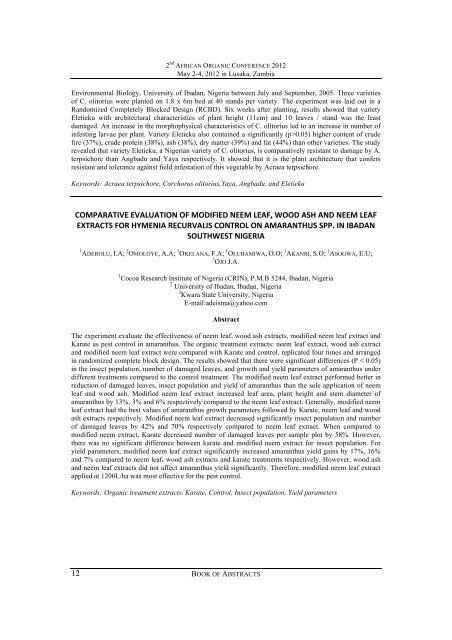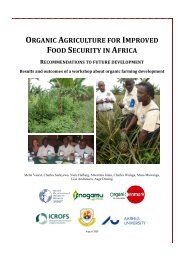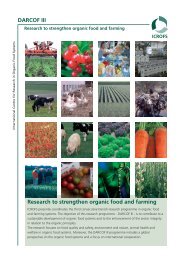The 2nd African Organic Conference â Mainstreaming ... - ICROFS
The 2nd African Organic Conference â Mainstreaming ... - ICROFS
The 2nd African Organic Conference â Mainstreaming ... - ICROFS
Create successful ePaper yourself
Turn your PDF publications into a flip-book with our unique Google optimized e-Paper software.
2 nd AFRICAN ORGANIC CONFERENCE 2012<br />
May 2-4, 2012 in Lusaka, Zambia<br />
Environmental Biology, University of Ibadan, Nigeria between July and September, 2005. Three varieties<br />
of C. olitorius were planted on 1.8 x 6m bed at 40 stands per variety. <strong>The</strong> experiment was laid out in a<br />
Randomized Completely Blocked Design (RCBD). Six weeks after planting, results showed that variety<br />
Eletieku with architectural characteristics of plant height (11cm) and 10 leaves / stand was the least<br />
damaged. An increase in the morphophysical characteristics of C. olitorius led to an increase in number of<br />
infesting larvae per plant. Variety Eletieku also contained a significantly (p>0.05) higher content of crude<br />
fire (37%), crude protein (38%), ash (38%), dry matter (39%) and fat (44%) than other varieties. <strong>The</strong> study<br />
revealed that variety Eletieku, a Nigerian variety of C. olitorius, is comparatively resistant to damage by A.<br />
terpsichore than Angbadu and Yaya respectively. It showed that it is the plant architecture that confers<br />
resistant and tolerance against field infestation of this vegetable by Acraea terpsichore.<br />
Keywords: Acraea terpsichore, Corchorus olitorius,Yaya, Angbadu, and Eletieku<br />
COMPARATIVE&EVALUATION&OF&MODIFIED&NEEM&LEAF,&WOOD&ASH&AND&NEEM&LEAF&<br />
EXTRACTS&FOR&HYMENIA&RECURVALIS&CONTROL&ON&AMARANTHUS&SPP.&IN&IBADAN&<br />
SOUTHWEST&NIGERIA&<br />
1 ADEROLU, I.A; 2 OMOLOYE, A.A; 1 OKELANA, F.A; 1 OLUBAMIWA, O.O; 1 AKANBI, S.O; 1 ASOGWA, E.U;<br />
3 OJO J.A.<br />
1 Cocoa Research Institute of Nigeria (CRIN), P.M.B 5244, Ibadan, Nigeria<br />
2 University of Ibadan, Ibadan, Nigeria<br />
3 Kwara State University, Nigeria<br />
E-mail:adeisma@yahoo.com<br />
Abstract<br />
<strong>The</strong> experiment evaluate the effectiveness of neem leaf, wood ash extracts, modified neem leaf extract and<br />
Karate as pest control in amaranthus. <strong>The</strong> organic treatment extracts: neem leaf extract, wood ash extract<br />
and modified neem leaf extract were compared with Karate and control, replicated four times and arranged<br />
in randomized complete block design. <strong>The</strong> results showed that there were significant differences (P < 0.05)<br />
in the insect population, number of damaged leaves, and growth and yield parameters of amaranthus under<br />
different treatments compared to the control treatment. <strong>The</strong> modified neem leaf extract performed better in<br />
reduction of damaged leaves, insect population and yield of amaranthus than the sole application of neem<br />
leaf and wood ash. Modified neem leaf extract increased leaf area, plant height and stem diameter of<br />
amaranthus by 13%, 3% and 6% respectively compared to the neem leaf extract. Generally, modified neem<br />
leaf extract had the best values of amaranthus growth parameters followed by Karate, neem leaf and wood<br />
ash extracts respectively. Modified neem leaf extract decreased significantly insect population and number<br />
of damaged leaves by 42% and 70% respectively compared to neem leaf extract. When compared to<br />
modified neem extract, Karate decreased number of damaged leaves per sample plot by 58%. However,<br />
there was no significant difference between karate and modified neem extract for insect population. For<br />
yield parameters, modified neem leaf extract significantly increased amaranthus yield gains by 17%, 16%<br />
and 7% compared to neem leaf, wood ash extracts and karate treatments respectively. However, wood ash<br />
and neem leaf extracts did not affect amaranthus yield significantly. <strong>The</strong>refore, modified neem leaf extract<br />
applied at 1200L/ha was most effective for the pest control.<br />
Keywords: <strong>Organic</strong> treatment extracts, Karate, Control, Insect population, Yield parameters<br />
12<br />
BOOK OF ABSTRACTS





